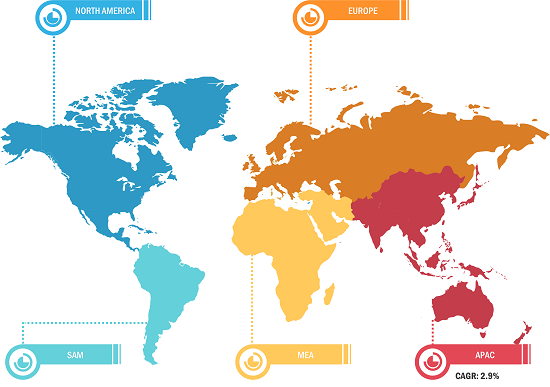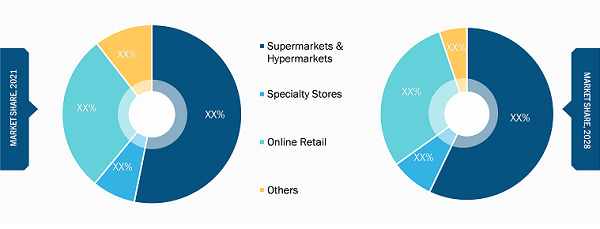水産物市場は、2022 年の 1 兆 7,149 億 393 万米ドルから 2022 年の米ドルに成長すると予想されています2031年までに2兆12億5,349万人。 2022 年から 2031 年にかけて 3.0% の CAGR で成長すると予想されています。
食品医薬品局 (FDA) は、魚介類には市販の海水魚、淡水魚、軟体動物の貝類、甲殻類がすべて含まれると述べています。魚介類の需要は、その健康上の利点により、世界中で劇的な成長を遂げると予想されています。食糧農業機関 (FAO) によると、今後数年間で高まる需要を満たすには、2030 年までに最大 30% 増にあたる 4,000 万トンの追加価値の水産物が必要となります。また、輸入水産物に対する富裕国の需要に伴う一人当たり消費量の増加が、予測期間中の市場の成長を支えると予想されます。
アジア太平洋地域がシーフード マーケット」。日本、中国、韓国などの国では、文化の中で魚が伝統的に重要視されています。したがって、これらの国における魚の高い需要が水産産業の成長を促進すると考えられます。新鮮な魚介類に加えて、缶詰の魚介類もこの地域の人々に広く受け入れられています。たとえば、マグロはその魅力的な味と複数の味とうまくブレンドできるため、アジアの人々の間で非常に人気があります。ツナ缶製品は従来のものとは異なる独特の風味を示し、アジア太平洋市場に浸透しています。また、電子商取引サービスの成長による流通システムの強化も、水産物市場の成長を牽引しています。
戦略的洞察
水産物市場の内訳 –地域別

マーケット インサイト
冷凍および缶詰シーフードの需要増加
水産加工品の需要の急増に伴い、冷凍および缶詰の水産製品の市場は世界中で急速に成長しています。冷凍魚介類製品は凍結処理されているため、食品の細菌の発生を防ぎ、保存期間を長くすることができます。同様に、魚の缶詰は、アルミニウム缶やブリキ缶などの密封された気密容器に入れて加工および保存されます。魚の缶詰の賞味期限は通常 1 ~ 5 年です。缶詰のシーフード製品は、インスタント食品の需要の高まりにより、消費者の間で大きな注目を集めています。同様に、冷凍シーフードも消費者に積極的に受け入れられており、市場の成長。新しい技術の導入により、冷凍魚介類は新鮮な魚介類と同様の栄養価と味を保持します。冷凍すると腐敗のプロセスが遅くなり、栄養価が保たれます。捕獲後数時間以内に冷凍された魚には、保存状態の良いビタミンが含まれています。新鮮な魚は劣化が早く、保存期間が短いことがわかっています。したがって、缶詰および冷凍シーフード製品の利便性と賞味期限の延長に対するニーズの高まりと、大手企業による研究開発活動の増加が、世界中のシーフード市場の成長を推進しています。
製品タイプベースの洞察
< p>水産物市場は、製品の種類に基づいて、魚、甲殻類、軟体動物などに分類されます。甲殻類セグメントは、予測期間中に最高の CAGR を記録すると予測されています。甲殻類は、世界中で約 45,000 種からなる無脊椎動物のグループである甲殻亜門 (節足動物門) のメンバーです。甲殻類のグループには、カニ、エビ、ロブスター、エビ、ザリガニ、オキアミ、フジツボなどの一般的に消費される魚介類が含まれます。これらは減量を助け、免疫力を高め、熱と体温の上昇を促進します。脳の健康。カニとカレーのカレー餃子、ロブスター ニューバーグ、鉢植えのエビ、モエチェ、エビのビスク、シリアルエビ、雌ガニのスープは、甲殻類を使って調理される最も有名な料理の一部であり、世界中で消費されています。流通チャネルに関する分析
水産物市場は流通に基づいて、スーパーマーケットやハイパーマーケット、専門店、オンライン小売などに分類されます。スーパーマーケットやスーパーマーケットは、ハイパーマーケットセグメントは、2021年に水産物市場で最大のシェアを占めました。スーパーマーケットとハイパーマーケットとは、幅広い種類の商品を販売するセルフサービスショップを指します。スーパーマーケットや大型スーパーマーケットには、シーフードの専用セクションがあります。したがって、特に冷凍部門において、顧客には幅広い選択肢が提供されます。スーパーマーケットや大型スーパーマーケットの水産物売り場は、さまざまな新鮮な魚介類や冷凍の魚介類を購入するのに最適な場所と考えられています。これらの要因がこのセグメントの成長を促進すると予測されています。
流通チャネル別のシーフード マーケット – 2022 年と 2031 年 < /strong>
< /strong>
水産物市場で活動する主要企業の一部American Seafoods Company LLC、Kangamiut Seafood A/C、Lee Fishing Company、Pacific American Fish Co. Inc.、Royal Greenland A/S、Mowi ASA、The Union Group PCL、Grupo Nueva Pescanova、Trident Seafoods Corporation、および SeaPak Shrimp です。 &シーフードカンパニー。これらの企業は、新たな消費者トレンドに対応し、規制の枠組みを遵守するために、健康リスクを軽減した製品の開発に取り組んでいます。彼らは、市場シェアを拡大するために、合併と買収、事業拡大、パートナーシップに取り組んでいます。
レポートの注目
- プレーヤーが効果的な長期戦略を立てるのに役立つ、水産物市場における進歩的な業界トレンド
- ビジネス成長戦略を採用先進市場と発展途上市場での確実な成長
- 2022 年から 2031 年までの水産物市場の定量分析
- 水産物の世界的な需要の推定
- 業界で活動するバイヤーとサプライヤーの有効性を説明するポーターのファイブ フォース分析
- 競争市場シナリオを理解するための最近の動向
- 市場動向と見通し、および水産物市場の成長を左右する要因
- 商業的利益を裏付け、市場の成長につながる市場戦略を強調することで意思決定プロセスを支援
- さまざまなノードにおける水産物市場の規模
- 市場と食品・飲料業界の動向の詳細な概要とセグメント化
- 有望な成長機会があるさまざまな地域の成長規模
- 過去2年間の分析、基準年、CAGRによる予測(7年間)
- PEST分析とSWOT分析
- 市場規模価値/数量 - 世界、地域、国
- 業界と競争環境
- Excel データセット
最新レポート
関連レポート
お客様の声
購入理由
- 情報に基づいた意思決定
- 市場動向の理解
- 競合分析
- 顧客インサイト
- 市場予測
- リスク軽減
- 戦略計画
- 投資の正当性
- 新興市場の特定
- マーケティング戦略の強化
- 業務効率の向上
- 規制動向への対応




















 無料サンプルを入手 - シーフードマーケット
無料サンプルを入手 - シーフードマーケット